Task Assignment of the Improved Contract Net Protocol under a Multi-Agent System
Abstract
1. Introduction
2. Improvement of the Contract Net Protocol Model
2.1. The Agent Model
2.2. The Dynamic Response Threshold Model
2.3. The Pheromone Flow Model
3. Task Allocation under the Improved Contract Net Protocol
3.1. Task Description
3.2. Contractor Agent Description
3.3. The Task Assignment Process
4. Simulation Experiment
4.1. Repast Simulation Platform
4.2. Experimental Settings
5. Results
5.1. Fixed Agent Quantity
5.2. Change of Agent Quantity
5.3. All Variables Fixed
6. Conclusions
- We set different task stimulus levels for different tasks and established the dynamic response threshold model to solve the problem of less restrictions on initial tender publication in traditional contract net protocols. A combination of history and norms was used to filter some meaningless contractors, and real-time adjust the trust level of contractor agents to reduce the traffic.
- The pheromone flow model was constructed, and the task pheromone released by the manager agent and the bidding pheromone released by the contractor agent were used to coordinate each other in the public environment to complete the task allocation model. Furthermore, a complete process was designed for the whole task allocation process.
- The Repast platform simulated the three experimental settings to get the tasks assignment: the number of tasks and the maximum load are uncertain, the number of agents is uncertain and all parameters are determined. The results show that the improved contract net protocol has the advantages of a small communication volume, short run-time, high task completion rate and multi-party coordination ability. Compared with the classical contract net protocol and dynamic contract net protocol, it has obvious advantages.
Author Contributions
Funding
Conflicts of Interest
References
- González-Briones, A.; De La Prieta, F.; Mohamad, M.; Omatu, S.; Corchado, J. Multi-agent systems applications in energy optimization problems: A state-of-the-art review. Energies 2018, 11, 1928. [Google Scholar] [CrossRef]
- Smith, R.G. The contract net protocol. High level communication and control in distributed problem solver. IEEE Trans. Comput. 1980, 29, 1104–1113. [Google Scholar] [CrossRef]
- Wunan, W.; Xiaojing, G.; Chunyu, S. Contract Net Model Based on Case Based Reasoning. Mini-Micro Syst. 2005, 26, 1578–1581. [Google Scholar]
- Chen, J.; Liao, S.; Deng, F. A collaboration algorithm for computer generated forces based on multi-agent systems. Comput. Simul. 2010, 27, 113–117. [Google Scholar]
- Sandbolm, T.W.; Lesser, V.R. Issues in automated negotiation and electronic commerce: Extending the contract net framework. In Proceedings of the First International Conference on Multi-Agent System, San Francisco, CA, USA, 12–14 June 1995; pp. 66–73. [Google Scholar]
- Zhang, H.; Shi, Z. Dynamic contract net protocol. Comput. Eng. 2004, 30, 44–57. [Google Scholar]
- Liu, L.; Gao, F. Research on the Negotiation Strategy of Mufti-agent Based on Extended Contract net. In Proceedings of the International Symposium on Parallel and Distributed Processing with Applications, Chengdu, China, 10–12 August 2009; pp. 11–18. [Google Scholar]
- Sun, D.; Wu, J. Multi-Agent coordination based on contract net protocol. In Proceedings of the 2009 International Symposium on Intelligent Ubiquitous Computing and Education, Chengdu, China, 15–16 May 2009; pp. 353–357. [Google Scholar]
- Carbó, J.; Molina, J.M.; Patricio, M.A. Asset Management System through the design of a Jadex Agent System. ADCAIJ Adv. Distrib. Comput. Artif. Intell. J. 2016, 5, 1–14. [Google Scholar] [CrossRef]
- González-Briones, A.; Prieto, J.; De La Prieta, F.; Herrera-Viedma, E.; Corchado, J.M. Energy optimization using a case-based reasoning strategy. Sensors 2018, 18, 865. [Google Scholar] [CrossRef] [PubMed]
- Giuseppe, C.; Marcello, F.; Giacome, L. A network flow based heuristic approach for optimizing AGV movements. J. Intell. Manuf. 2013, 24, 405–419. [Google Scholar]
- Buehler, J.; Pagnucco, M. A framework for task planning in heterogeneous multirobot systems based on robot capabilities. In Proceedings of the National Conference on Artificial Intelligence, Québec City, QC, Canada, 27–31 July 2014; pp. 2527–2533. [Google Scholar]
- Ming, L.; Wei, L.; Yanduo, Z. Mulit-Agent dynamic task allocation based on improved contract net protocol. J. Shandong Univ. 2016, 46, 51–56. [Google Scholar]
- Jensen, K.; Kristensen, L.M.; Wells, L. Coloured Petri Nets and CPN Tools for modelling and validation of concurrent systems. Int. J. Softw. Tools Technol. Transf. 2007, 9, 213–254. [Google Scholar] [CrossRef]
- Lee, W.; Kim, D. History-Based Response Threshold Model for Division of Labor in Multi-Agent Systems. Sensors 2017, 17, 1232. [Google Scholar] [CrossRef] [PubMed]
- Dorigo, M.; Maniezzo, V.; Colorni, A. Ant system: Optimization by a colony of cooperating agents. IEEE Trans. Syst. Man Cybern. 1996, 26, 29–41. [Google Scholar] [CrossRef] [PubMed]
- He, Z.; Huang, J.; Shuai, Y. Research on benefit allocation of multimodal transport based on ant colony’s labor division. J. China Railw. Soc. 2018, 40, 19–26. [Google Scholar]
- Yang, Y.; Liu, X. Task assignment based on improved dynamic contract net and ant colony search strategy. In Proceedings of the International Conference on Mechatronic Sciences, Shengyang, China, 20–22 December 2013. [Google Scholar]
- Xiang, W.; Lee, H.P. Ant colony intelligence in multi-agent dynamic manufacturing scheduling. Eng. Appl. Artif. Intell. 2008, 21, 73–85. [Google Scholar] [CrossRef]
- Xu, X. From cloud computing to cloud manufacturing. Robot. Comput. Integr. Manuf. 2012, 28, 75–86. [Google Scholar] [CrossRef]
- Wang, L. Research on Coordination Mechanism and Key Technique of Bio-Inspired Manufacturing System; Nanjing University of Acronautics and Astronautics: Nanjing, China, 2010. [Google Scholar]
- De Moraes, R.S.; De Freitas, E.P. Distributed control for groups of unmanned aerial vehicles performing surveillance missions and providing relay communication network services. J. Intell. Robot. Syst. 2017. [Google Scholar] [CrossRef]
- Panescu, D.; Pascal, C. Holonic coordination obtained by joining the contract net protocol with constraint satisfaction. Comput. Ind. 2015, 81, 36–46. [Google Scholar] [CrossRef]
- Hooshangi, N.; Alesheikh, A.A. Developing an Agent-Based Simulation System for Post-Earthquake Operations in Uncertainty Conditions: A Proposed Method for Collaboration among Agents. ISPRS Int. J. Geo-Inf. 2018, 7, 27. [Google Scholar] [CrossRef]
- Guo, C.; Xiong, W. Parallel Agent-based simulation of complex system based on repast HPC. In Proceedings of the International Symposium on Instrumentation & Measurement, Toronto, ON, Canada, 23–24 December 2013. [Google Scholar]
- Cao, Y.; Yu, W.; Ren, W.; Chen, G. An overview of recent progress in the study of distributed multi-Agent coordination. IEEE Trans. Ind. Inform. 2013, 9, 427–438. [Google Scholar] [CrossRef]
- González-Briones, A.; Villarrubia, G.; De Paz, J.F.; Corchado, J.M. A multi-agent system for the classification of gender and age from images. Comput. Vis. Image Understand. 2018, 172, 98–106. [Google Scholar] [CrossRef]
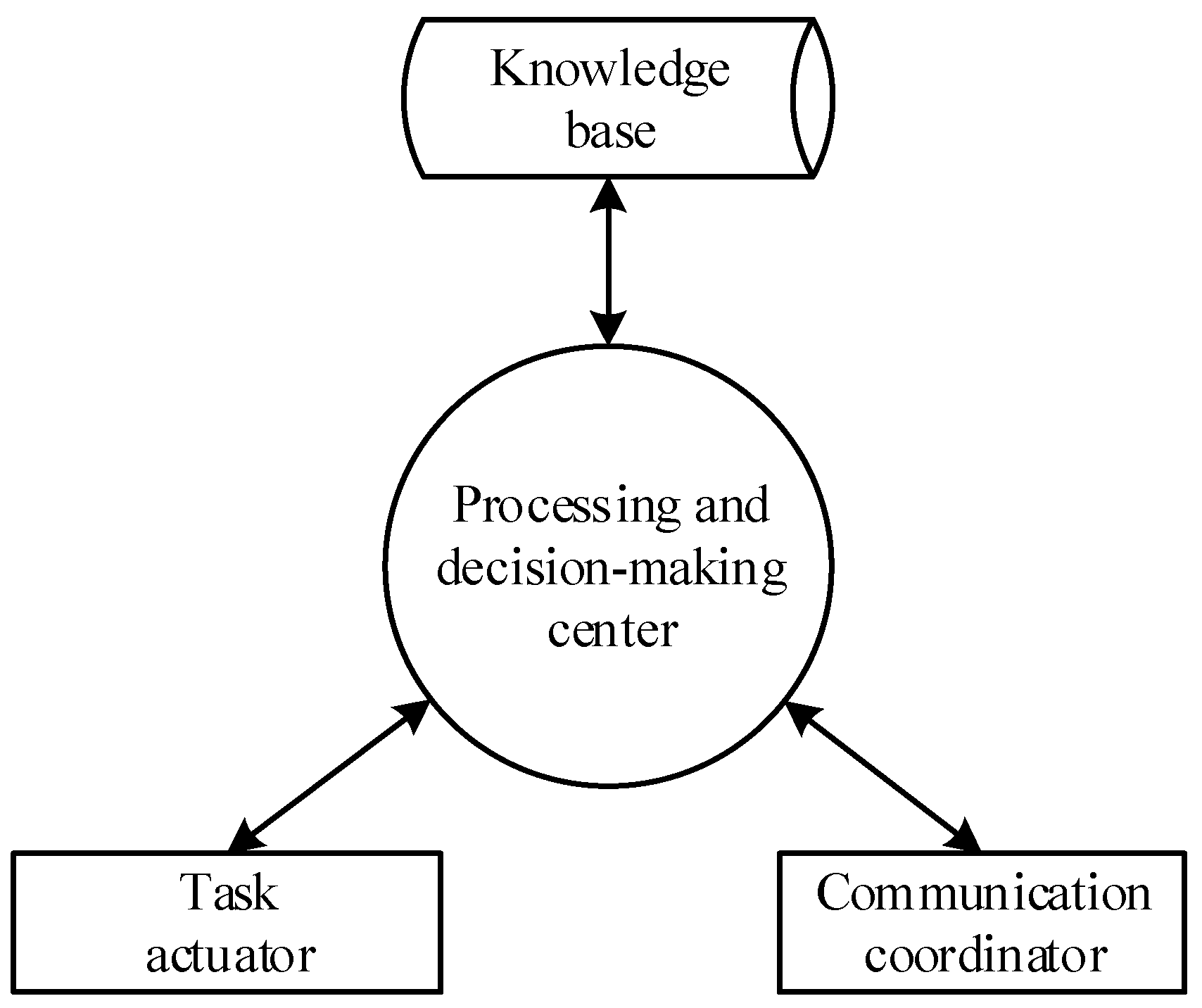
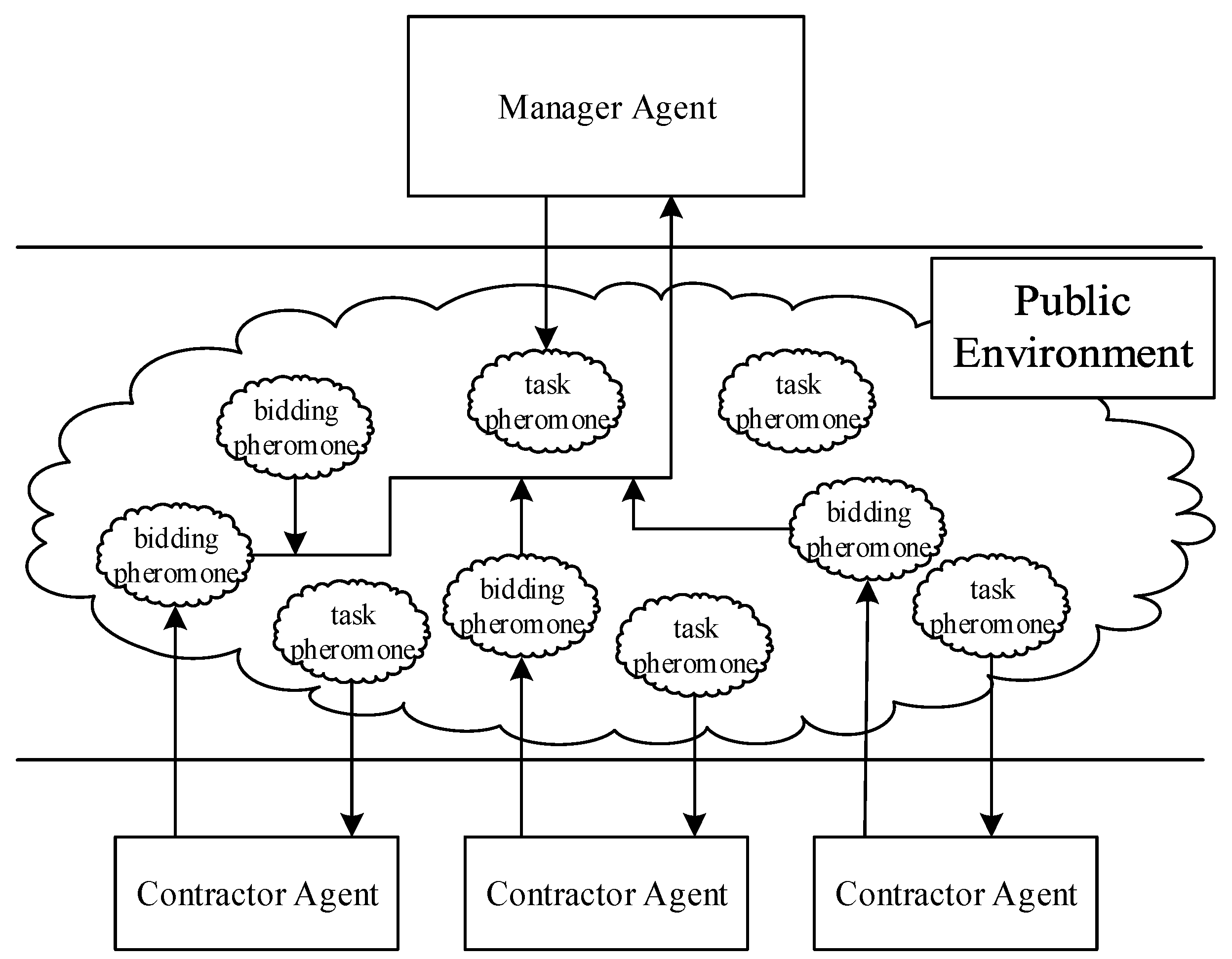

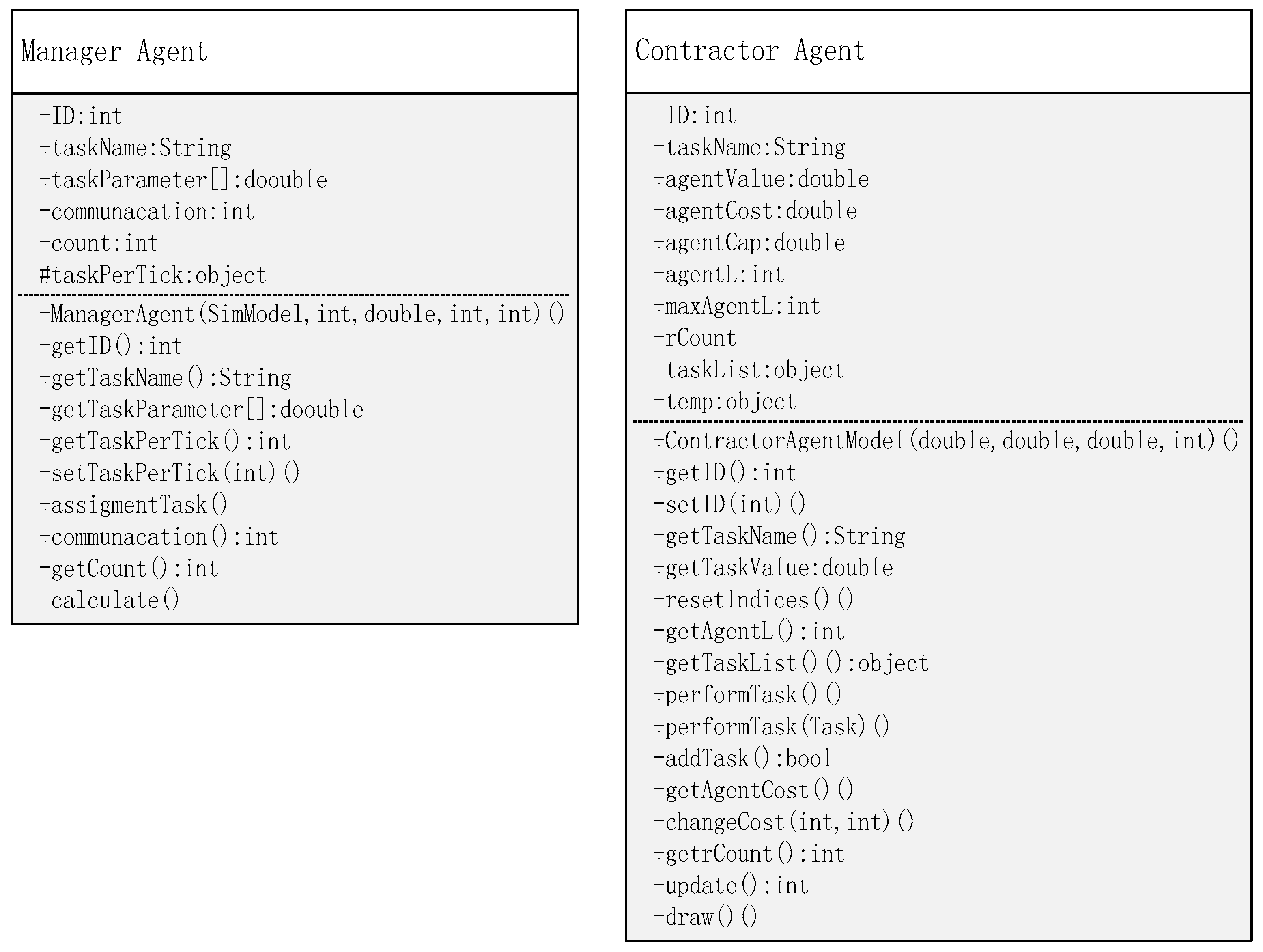
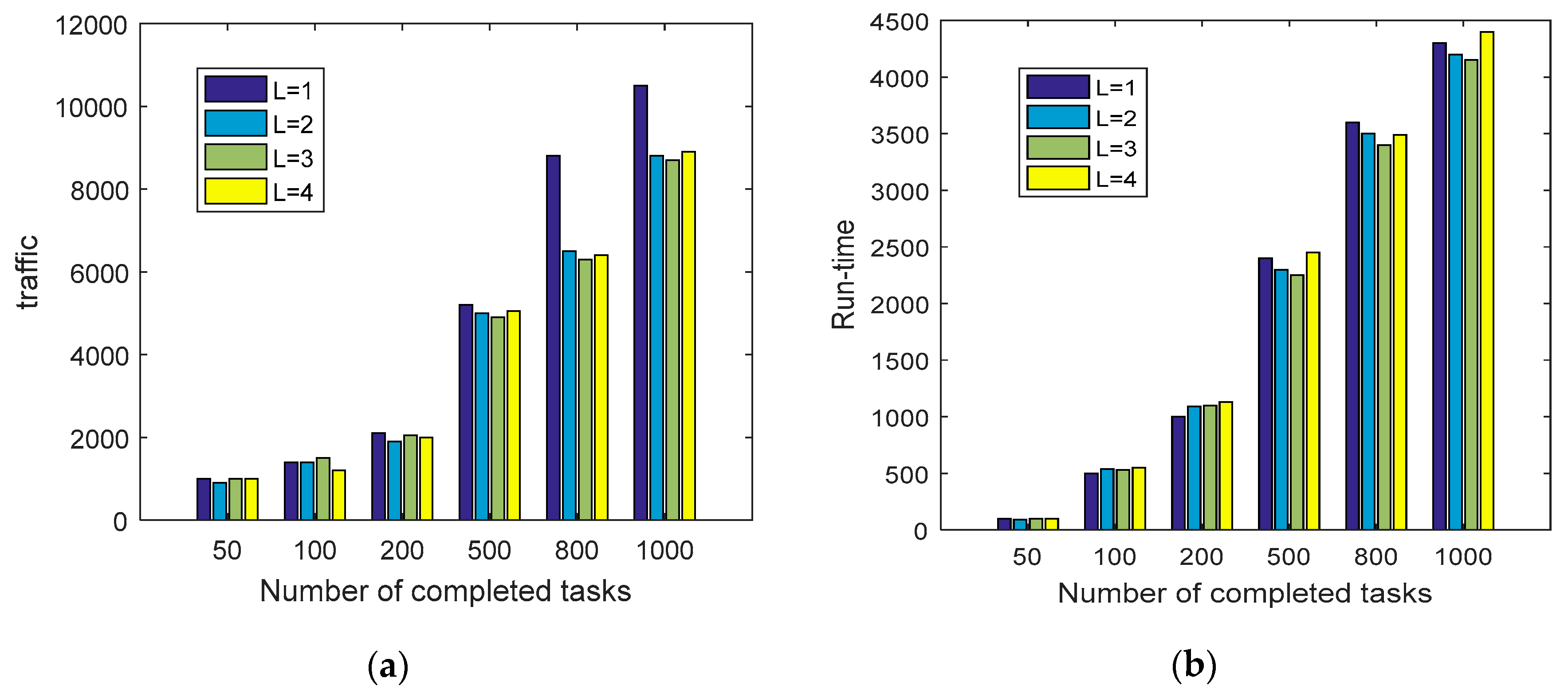
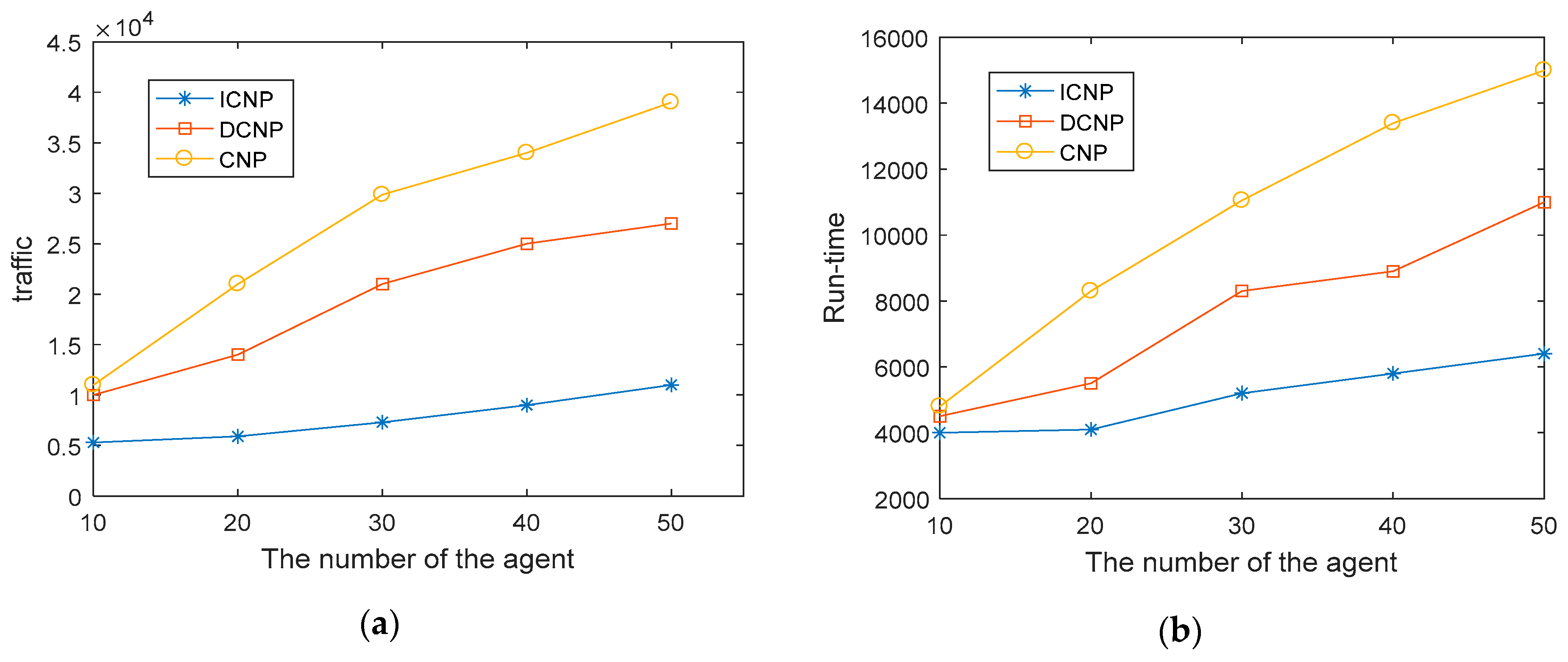
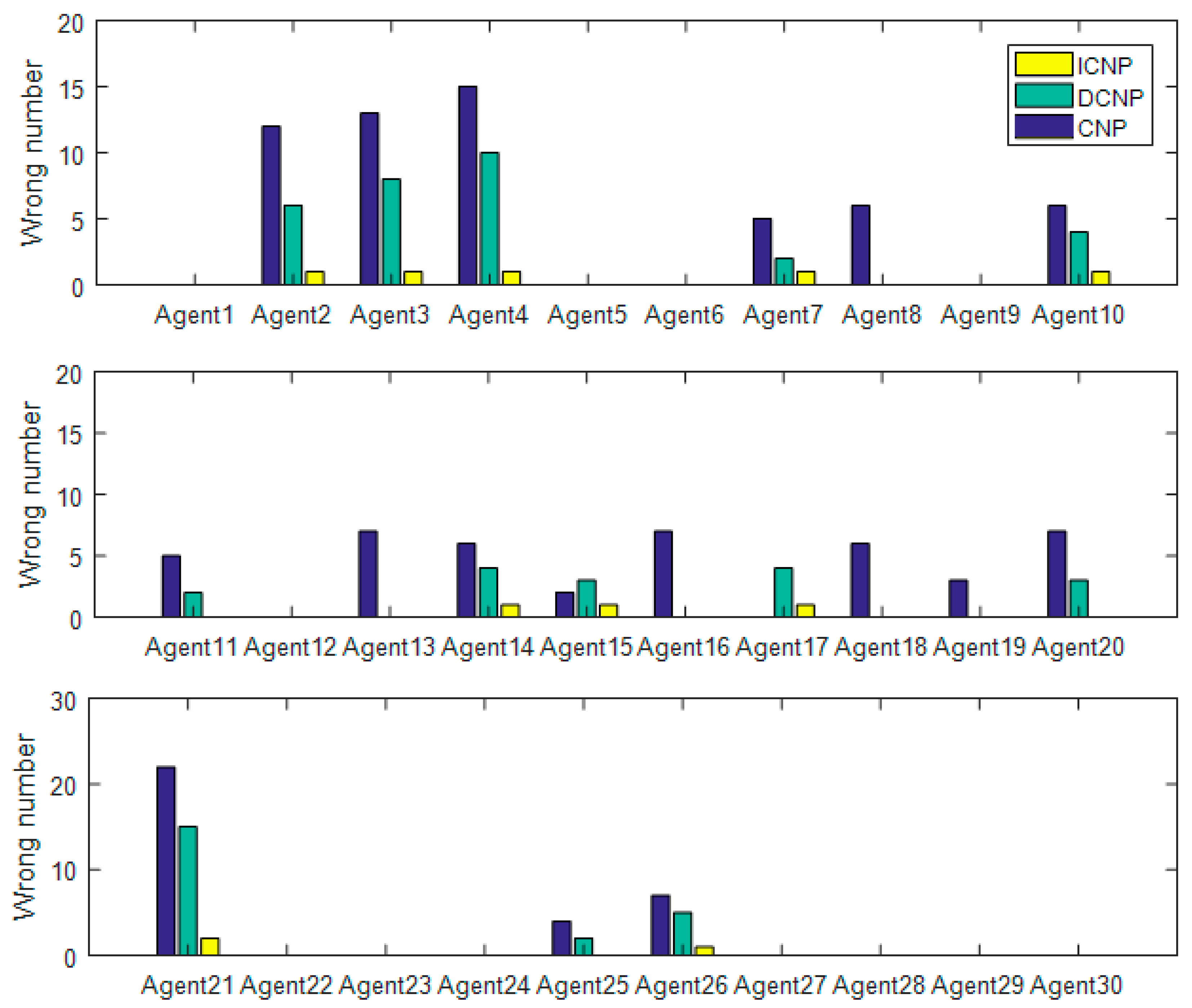
| Task Set | Task Number | Pri | Sti | Rew |
|---|---|---|---|---|
| M1 | 101 | 1 | 0.2 | 3.4 |
| 102 | 3 | 0.6 | 2.7 | |
| M2 | 201 | 2 | 0.4 | 1.6 |
| 202 | 2 | 0.6 | 4.2 | |
| M3 | 301 | 4 | 0.2 | 5.1 |
| 302 | 3 | 0.7 | 2.7 | |
| M4 | 401 | 3 | 0.1 | 3.4 |
| 402 | 5 | 0.8 | 5.1 | |
| M5 | 501 | 4 | 0.6 | 3.0 |
| 502 | 1 | 0.3 | 0.9 |
| Algorithms | Number of Error Tasks | Number of Successful Re-Forward Tasks | Task Completion Rate |
|---|---|---|---|
| CNP | 133 | 0 | 86.7% |
| DCNP | 68 | 0 | 93.2% |
| ICNP | 11 | 11 | 100% |
© 2019 by the authors. Licensee MDPI, Basel, Switzerland. This article is an open access article distributed under the terms and conditions of the Creative Commons Attribution (CC BY) license (http://creativecommons.org/licenses/by/4.0/).
Share and Cite
Zhang, J.; Wang, G.; Song, Y. Task Assignment of the Improved Contract Net Protocol under a Multi-Agent System. Algorithms 2019, 12, 70. https://doi.org/10.3390/a12040070
Zhang J, Wang G, Song Y. Task Assignment of the Improved Contract Net Protocol under a Multi-Agent System. Algorithms. 2019; 12(4):70. https://doi.org/10.3390/a12040070
Chicago/Turabian StyleZhang, Jiarui, Gang Wang, and Yafei Song. 2019. "Task Assignment of the Improved Contract Net Protocol under a Multi-Agent System" Algorithms 12, no. 4: 70. https://doi.org/10.3390/a12040070
APA StyleZhang, J., Wang, G., & Song, Y. (2019). Task Assignment of the Improved Contract Net Protocol under a Multi-Agent System. Algorithms, 12(4), 70. https://doi.org/10.3390/a12040070





